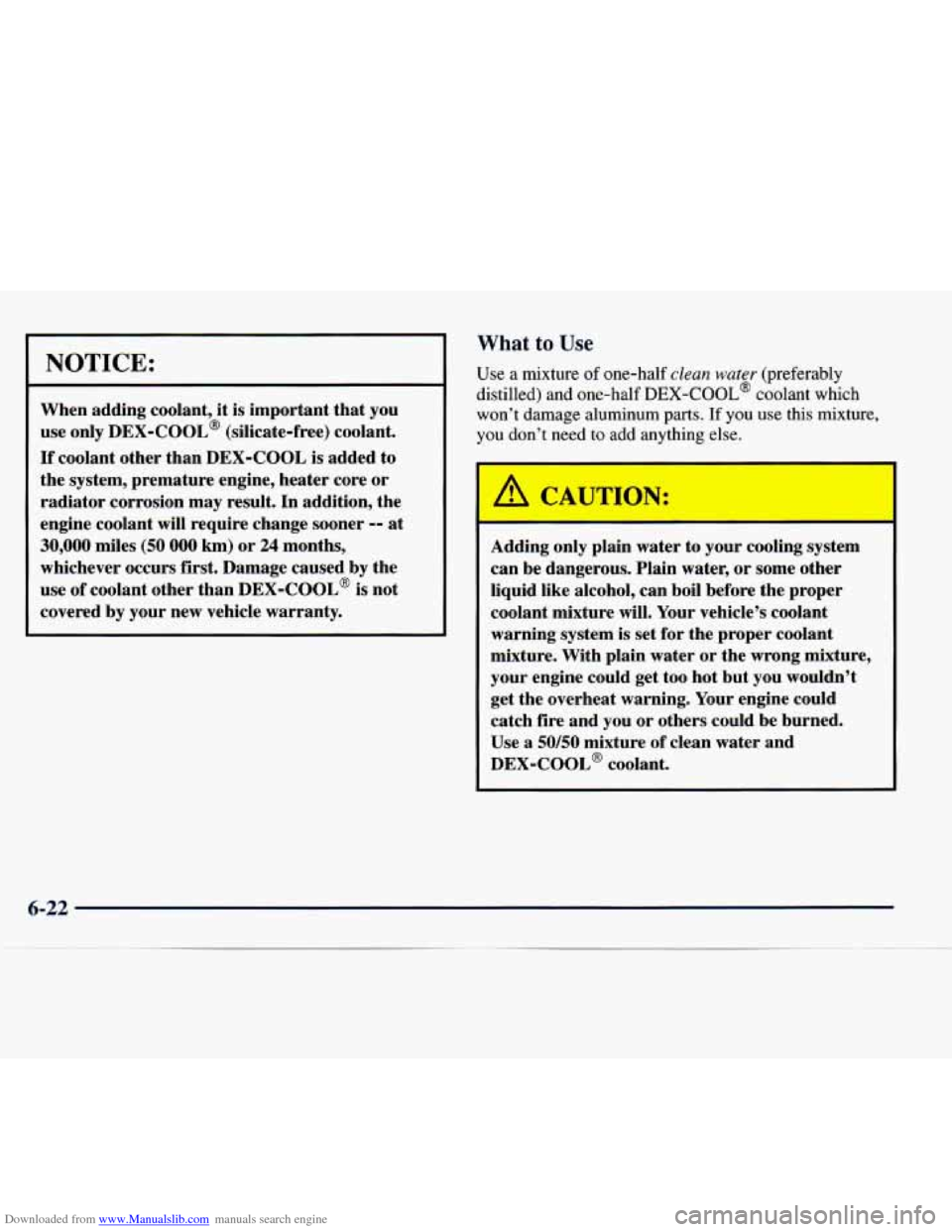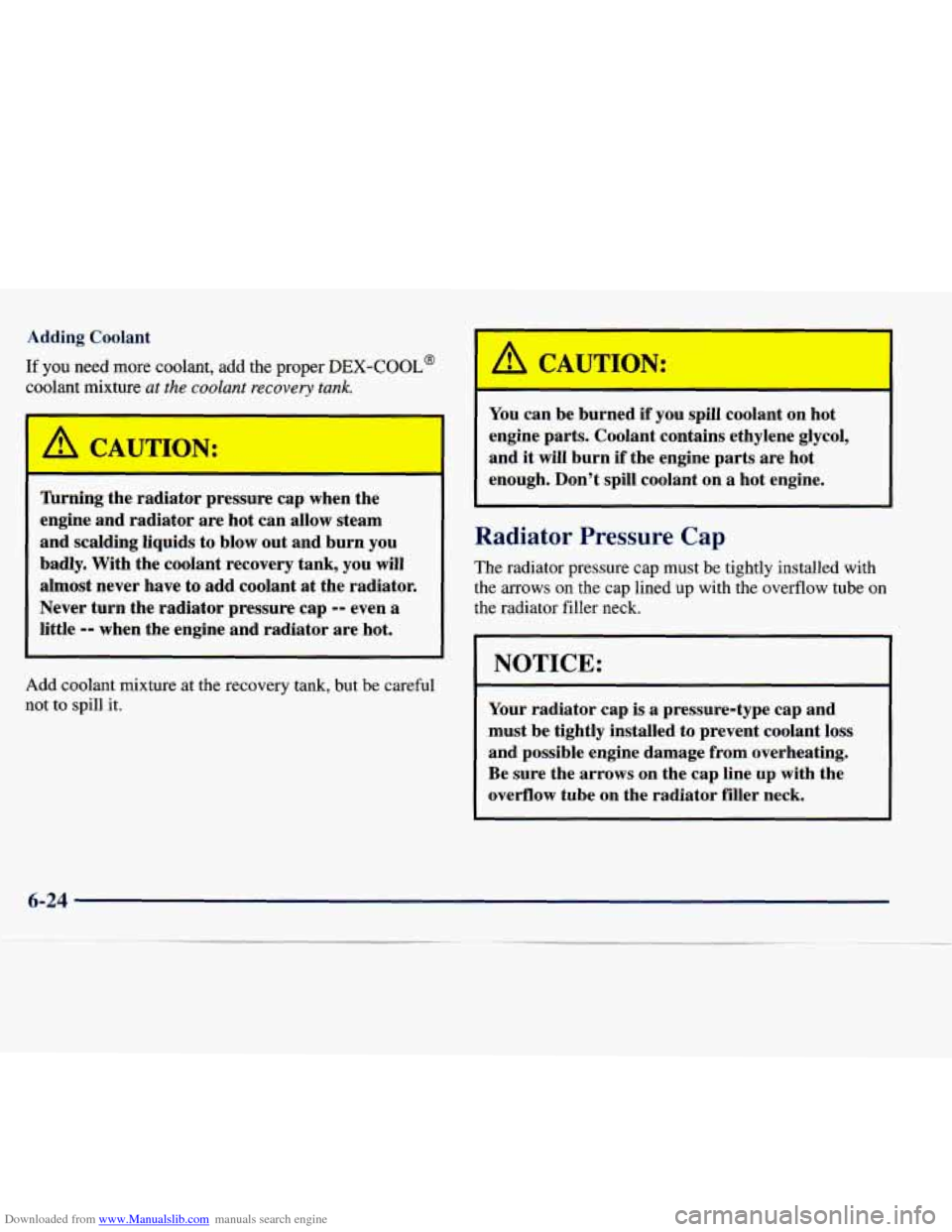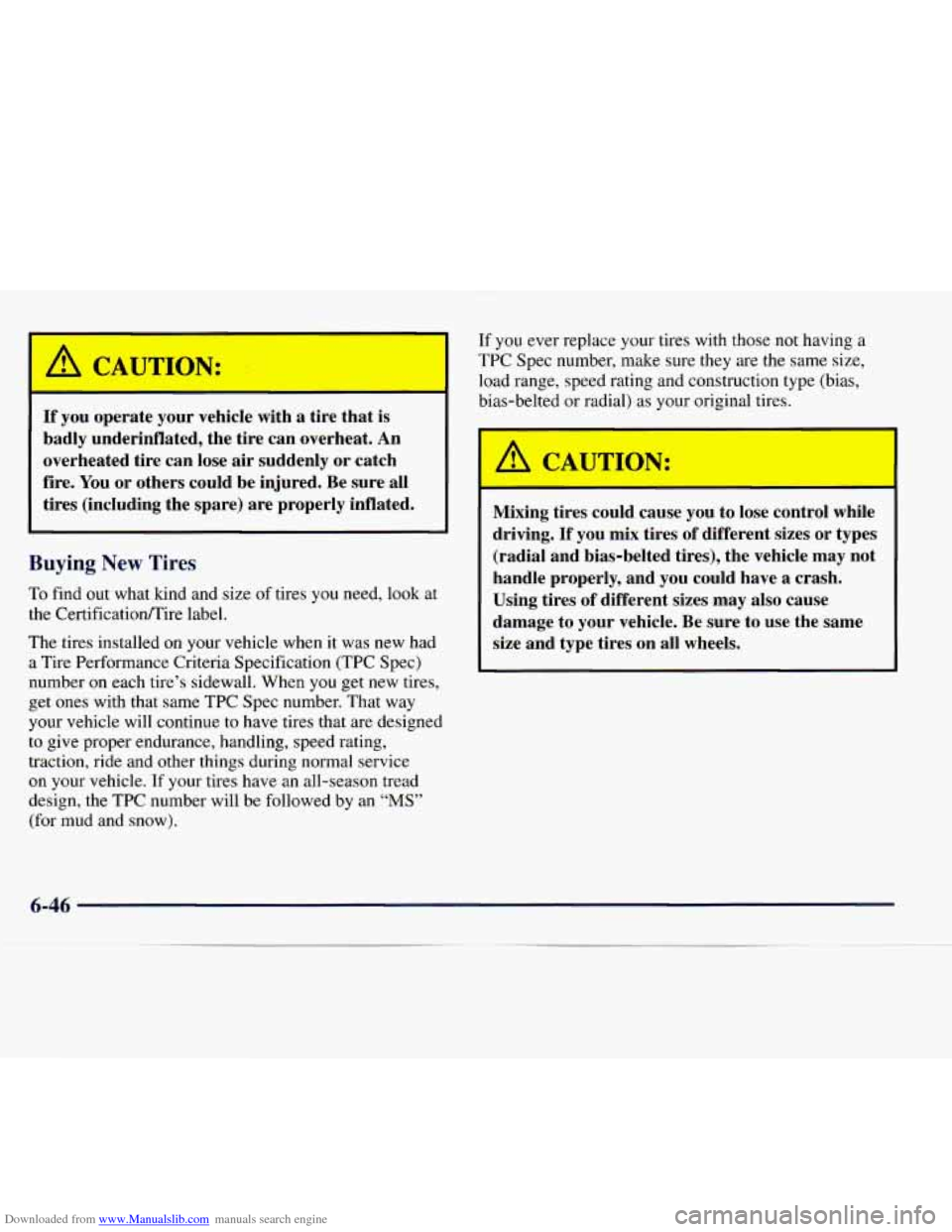1998 CHEVROLET EXPRESS engine overheat
[x] Cancel search: engine overheatPage 261 of 386

Downloaded from www.Manualslib.com manuals search engine NOTICE:
When adding coolant, it is important that you
use only
DEX-COOL@ (silicate-free) coolant.
If coolant other than DEX-COOL is added to
the system, premature engine, heater core or
radiator corrosion may result. In addition, the
engine coolant will require change sooner
-- at
30,000 miles (50 000 km) or 24 months,
whichever occurs first. Damage caused by the
use
of coolant other than DEX-COOL@ is not
covered by your new vehicle warranty.
What to Use
Use a mixture of one-half clean water (preferably
distilled) and one-half
DEX-COOL@ coolant which
won’t damage aluminum parts. If you use this mixture,
you don’t need to add anything else.
I
Adding only plain water to your cooling system
can be dangerous. Plain water, or some other
liquid like alcohol, can boil before the proper
coolant mixture will. Your vehicle’s coolant
warning system is set for the
proper coolant
mixture. With plain water or the wrong mixture,
your engine could get too hot but you wouldn’t
get the overheat warning. Your engine could
catch fire and you or others could be burned.
Use a
50/50 mixture of clean water and
DEX-COOL@ coolant.
6-22
Page 262 of 386

Downloaded from www.Manualslib.com manuals search engine NOTICE:
If you use an improper coolant mixture, your
engine could overheat and be badly damaged.
The repair cost wouldn’t be covered by your
warranty. Too much water in the mixture can
freeze and crack the engine, radiator, heater core
and other parts.
If you have to add coolant more than four times a year,
have your dealer check your cooling system.
NOTICE:
Checking Coolant
If you use the proper coolant, you don’t have to
add extra inhibitors or additives which claim to
improve the system. These can be harmful. When
your engine is cold, the coolant level shoi FULL COLD, or a little higher. Ad
be
at
Page 263 of 386

Downloaded from www.Manualslib.com manuals search engine Adding Coolant
If you need more coolant, add the proper DEX-COOL'
coolant mixture at the coolant recovery tank.
I
Wrning the radiator pressure cap when the
engine and radiator are hot can allow steam
and scalding liquids to blow out and burn you
badly. With the coolant recovery tank, you will
almost never have
to add coolant at the radiator.
Never turn the radiator pressure cap
-- even a
little
-- when the engine and radiator are hot.
Add coolant mixture at the recovery tank, but be careful
not to spill it.
A CAUTION:
You can be burned if you spill coolant on hot
engine parts. Coolant contains ethylene glycol,
and it will burn
if the engine parts are hot
enough. Don't spill coolant on
a hot engine.
Radiator Pressure Cap
The radiator pressure cap must be tightly installed with
the arrows
on the cap lined up with the overflow tube on
the radiator filler neck.
NOTICE:
Your radiator cap is a pressure-type cap and
must be tightly installed to prevent coolant loss
and possible engine damage from overheating.
Be sure the arrows on the cap line up with the
overflow tube on the radiator filler neck.
6-24
Page 280 of 386

Downloaded from www.Manualslib.com manuals search engine 2.
3.
4.
5.
6.
7.
Press down on the blade assembly pivot locking tab.
Pull down on the blade assembly to release it from
the wiper arm hook.
Remove the insert from the blade assembly. The
insert has two notches at one end that are locked by
bottom claws
of the blade assembly. At the notched
end, pull
the insert from the blade assembly.
To install the new wiper insert, slide the notched
end last, into the end with two blade claws. Slide
the insert all the way through the blade claws at the
opposite end.
Be sure that the notches are locked by the bottom
claws. Make sure that all other claws are properly
locked
on both sides of the insert slot.
Put the blade assembly pivot in the wiper arm
hook. Pull up until the pivot locking tab locks in
the hook slot.
Carefully lower the wiper
arm and blade assembly
into the windshield.
Tires
Yo%fS%%v vehicle comes with high-quality tires made by
a leading tire manufacturer. If you ever have questions
about your tire warranty and where to
obtain service, see
your
GM Warranty booklet for details.
A CAUTIOI.:
Poorly maintained and improperly used tires
are dangerous.
0
0
0
0
Overloading your tires can cause
overheating as
a result of too much friction.
You could have an air-out and a serious
accident. See “Loading Your Vehicle” in
the Index.
Underinflated tires pose the same danger
as overloaded tires. The resulting accident
could cause serious injury. Check all tires
frequently to maintain the recommended
pressure. Tire pressure should be checked
when your tires are cold.
Overinflated tires are more likely
to be
cut, punctured
or broken by a sudden
impact
-- such as when you hit a pothole.
Keep tires at the recommended pressure.
Worn, old tires can cause accidents.
If your
tread is badly worn, or if your tires have
been damaged, replace them.
6-41
Page 285 of 386

Downloaded from www.Manualslib.com manuals search engine I A CAUTION:
If you operate your vehicle with a tire that is
badly underinflated, the tire can overheat.
An
overheated tire can lose air suddenly or catch
fire. You or others could be injured. Be sure all
tires (including the spare) are properly inflated.
Buying New Tires
To find out what kind and size of tires you need, look at
the CertificatiodTire label.
The tires installed
on your vehicle when it was new had
a Tire Performance Criteria Specification (TPC Spec)
number on each tire’s sidewall. When you get new tires,
get ones with that same TPC Spec number. That way
your vehicle will continue
to have tires that are designed
to give proper endurance, handling, speed rating,
traction, ride and other things during normal service
on your vehicle. If your tires have an all-season tread
design, the TPC number will be followed by an
“MS”
(for mud and snow). If you
ever replace your tires with those
not having a
TPC Spec number, make sure they are the same size,
load range, speed rating and construction type (bias,
bias-belted or radial) as your original tires.
Mixing tires could cause you to lose control while
driving.
If you mix tires of different sizes or types
(radial and bias-belted tires), the vehicle may not
handle properly, and you could have a crash.
Using tires
of different sizes may also cause
damage
to your vehicle. Be sure to use the same
size and type tires on all wheels.
Page 300 of 386

Downloaded from www.Manualslib.com manuals search engine Electrical System
Add-on Electrical Equipment
NOTICE:
Don’t add anything electrical to your vehicle
unless you check with your dealer first. Some
electrical equipment can damage your vehicle
and the damage wouldn’t be covered by your
warranty. Some add-on electrical equipment
can keep other components from working
as
they should.
Your vehicle has an air bag system. Before attempting to
add anything electrical to your vehicle,
see “Servicing
Your Air Bag-Equipped Vehicle”
in the Index.
Headlamp Wiring
The headlamp wiring is protected by a circuit breaker in
the lamp switch. An electrical overload will cause the
lamps to flicker on and off, or in some cases to remain
off.
If this happens, have your headlamp wiring checked
right away.
Windshield Wiper Fuses
The windshield wiper motor is protected by a circuit
breaker and a fuse.
If the motor overheats due to heavy
snow, etc., the wiper will stop until the motor cools.
Although the circuit
is protected from electrical
overload, overload due to heavy snow, etc., may cause
wiper linkage damage. Always clear ice and heavy snow
from the the windshield before using the windshield
wipers.
If the overload is caused by some electrical
problem and not snow, etc., be sure to get it fixed.
Page 377 of 386

Downloaded from www.Manualslib.com manuals search engine Engine ....................................... 6-10
Coolant
..................................... 6-21
Coolant Level Check
.......................... 7-38
Coolant Temperature Gage
..................... 2-57
Cooling System
.............................. 5- 14
Exhaust
...................... 2.29.2.30.2.33 .4.26
FuseBlock
.................................. 6-65
Identification
........................... 6.60. 6.67
OilLevelCheck
.............................. 7-38
Overheating
................................. 5-11
Running While Parked ......................... 2-30
Starting Your
................................ 2- 18
EngineOil
.................................... 6-12
Adding
..................................... 6-13
Additives
................................... 6-15
Checking ................................... 6-13
Pressure Gage
................................ 2-60
Used
....................................... 6-16
Whentochange
.............................. 6-15
Exhaust, Engine
................. 2-29.2-30,2-33, 4-26
Engine Coolant Heater
........................... 2-20
Engine Oil (Continued)
Exterior Lamps
................................. 2-40
Fabric Cleaning
............................... 6-52
Filling a Portable Fuel Container .................... 6-7
FillingYourTank
................................ 6-5
Filter. Air
..................................... 6-16
Finish Care
.................................... 6-55
Finish Damage
................................. 6-57 First Gear. Automatic Transmission
................ 2-23
Flashers. Hazard Warning
......................... 5-2
Flat Tire. Changing
............................. 5-22
Fluids and Lubricants
............................ 7-44
Foreign Countries. Fuel
........................... 6-5
French Language Manual
11
Front Parkingnurn Signal Lamp Bulb Replacement .... 6-35
Front Storage Area
.............................. 2-48
FrontTowing
.................................. 5-10
Fuel .......................................... 6-3
Canada ...................................... 6-3
Filling
a Portable Container ...................... 6-7
FillingYourTank
.............................. 6-5
Gage
....................................... 2-63
In Foreign Countries
........................... 6-5
Tankcapacity
............................... 6-69
Fuses and Circuit Breakers
....................... 6-61
.. ...........................
Gages
Engine Coolant Temperature
.................... 2-57
Engine Oil Pressure
........................... 2-60
Fuel
....................................... 2-63
Speedometer
................................. 2-52
Voltmeter
................................... 2-55
GAWR
....................................... 4-27
Gear Positions. Automatic Transmission
............. 2-21
Gross Axle Weight Rating
........................ 4-27
Gross Vehicle Weight Rating
...................... 4-27
Guide en Franpis
11
GVWR ....................................... 4-27
.. .................................
9-4
Page 380 of 386

Downloaded from www.Manualslib.com manuals search engine Off-Road Recovery ............................. 4- 1 1
Oil. Engine .................................... 6-12
Overheating Engine
............................. 5- 1 1
Owner Checks and Services ....................... 7-38
Owner Publications. Ordering
................ 8- 1 1. 8- I2
Paint Spotting. Chemical
........................ 6-58
Park Automatic Transmission
....................... 2-21
Shifting Into
................................. 2-25
Shifting Out of
............................... 2-28
AtNight
.................................... 2-15
Brake ...................................... 2-24
BrakeMechanismCheck
....................... 7-41
Over Things That Burn
........................ 2-29
With a Trailer
................................ 4-36
Passenger Position
.............................. 1-26
Passing
................................... 4-11
Passlock
..................................... 2-16
Periodic Maintenance Inspections
.................. 7-42
Power
Antenna Mast Care
............................ 3-27
DoorLocks
................................... 2-5
Remote Control Mirror
........................ 2-45
Seat
......................................... 1-3
Steering
..................................... 4-8
Steering Fluid
................................ 6-25
Windows
................................... 2-31
Pregnancy. Use
of Safety Belts .................... 1-25
Parking
Lots
....................................... 2-16
8 *.
Problems on the Road ............................ 5-1
Publications. Service and Owner
.............. 8- 1 1. 8- 12
Radiator
..................................... 5-18
Radiator Pressure Cap ........................... 6-24
Radio Reception
................................ 3-23
Radios
.......................... 3-7.3-9.3-11. 3- 16
Rain. Driving In
................................ 4-15
Reading Lamps
................................ 2-43
Rear Axle
....................................... 6-21
Door Security Locks
........................... 2-5
Outside Seat Position
.......................... 1-34
Seatpassengers
.............................. 1-34
Towing
..................................... 5-11
Rear Air Conditioning and Rear Heater
............... 3-5
Rear Heater Controls (without Air Conditioning)
....... 3-4
Rear Passenger Temperature Control
................. 3-5
Rear Safety Belt Comfort Guides
.................. 1-37
Rearview Mirror
................................ 2-45
Reclining Front Seatbacks
......................... 1-3
Recommended Fluids and Lubricants
............... 7-44
Recovery Tank. Coolant
.......................... 5-16
Refrigerants. Air Conditioning
.................... 6-70
Remote Compact Disc Player
..................... 3-20
Replacement Bulbs
...................................... 6-66
Parts
....................................... 6-69
Wheel
...................................... 6-49
Replacing Safety
Belts ........................... 1-62
Reporting Safety Defects
.................... 8- 10. 8- 1 1
9-7